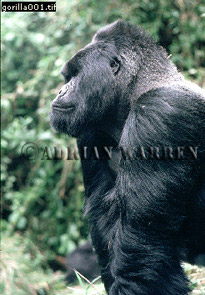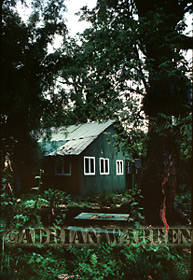|
MOUNTAIN
GORILLAS
by
Adrian Warren

Mountain Gorilla (Gorilla g. beringei), Virunga
Volcanoes, Rwanda
A number of expeditions
followed, notably that of Carl Akeley who, in 1921 went to the Virunga
Mountains to collect Mountain Gorilla specimens for a diorama exhibit
in the American Museum of Natural History in New York. His expedition
team included an eight year old girl, Alice Bradley and he documented
the adventure not only with still photographs but also with a 35mm. movie
camera which he designed and built himself. With that camera he took the
first ever movie shots of Mountain Gorillas. The killing of his first
gorilla, a silverback which he called "The Old Man of Mikeno"
after the mountain of the same name, was not only a turning point in Akeley's
life but also in the destiny of the mountain gorillas. Looking into the
dead gorilla's face, he had a change of heart. Recognising their closeness
to us, their intelligence, and their gentleness, he didn't want to kill
any more. He also recognised their apparent rarity and, therefore, the
need for research into their natural history. His party collected five
gorillas which still form an important exhibit in New York. Following
his expedition, Carl Akeley urged the Belgian Government to set up a permanent
sanctuary for the mountain gorillas, and became instrumental in the establishment
of the Albert National Park on 21 April 1925, and on 9 July 1929 the boundaries
of the Park were extended to include the entire Virunga volcano chain.
Seventy years later, the
volcanoes are still protected, though divided by the political boundaries
of Zaire, Rwanda and Uganda. Today, the gorillas' home is an island surrounded
by cultivated land inhabited by one of the densest population of people
to be found anywhere in Africa. In January 1991, standing on the rim of
the volcano called Visoke, at around 11,400 feet above sea level, I had
a spectacular view of the forest and the line of volcanoes but the view
also showed me the stark line between the forest and the endless cultivation;
it made me appreciate the isolation and fragility of this tiny piece of
pristine land. With me were George and Kay Schaller, returning here after
an absence of thirty one years. While we were standing there, breathing
in the wonderful unpolluted air and surrounded by that very special community
of African sub-alpine plants, including giant Senecios and Lobelias, we
could hear intermittent gunfire to the East. The latest round of squabbles
between humans trapped by overcrowding problems and obsessed by survival
and greed seemed to underline the pathetic and hopeless future for the
land on which we stood.
It is to this forest that
George and Kay came, in 1959, to conduct the first exhaustive field study
of mountain gorillas. George used to do all his own tracking, following
the trail of beaten down vegetation, smelling the fresh droppings and
touching them to see if they were warm or cool. "Finally, far ahead
I would hear a branch snapping, then a sort of grumbling sound and then
I used to look for the nearest tree, not to escape but to climb up high
enough to look down on them. A couple of times I made a mistake and found
myself right in the middle of the group with gorillas all around me -
the interesting thing was that they seemed to realise that I'd made a
mistake and that I wasn't the least bit aggressive. I used to back away
and the gorillas would continue their daily routine. Occasionally a male
was annoyed at my presence and roared and beat his chest. It is interesting
that I was never once charged by a gorilla, partly, I think, because I
didn't push them". By observing from a tree, George gained the gorillas'
confidence since they could see him clearly and he had a better view for
making his observations. Down below, he could approach much more closely
to the gorillas, but never get a good look at one. "You can hear
branches breaking, sometimes you see a black arm reaching out but although
you know much interesting behaviour is occuring you can't see it because
of the dense vegetation". George would stay with his study group
all day, and often all night too: "towards dusk, the male would go
somewhere to start building his nest, and the others would all go and
start building nests, I would blow up my air mattress and lie down near
them and sleep pulling a tarp over my head, staying with them until morning
when I would watch them awake, stretch their arms, yawn and start eating.
It was wonderful to get into the daily routine at their speed, not my
speed; trying to adapt to their rhythm of life - that was one of my great
field experiences". In little over a year of dedicated and painstaking
work ,the Schallers made huge advances in our knowledge of gorillas and
their behaviour, and the results of that research are still regarded as
the "bible" for those who have followed.

Dian Fossey's Cabin,
Karisoke
research centre, Rwanda
The late Dian Fossey,while
not recognised as a high calibre field biologist, did much to bring the
plight of a dwindling population of mountain gorillas to world attention
during the nearly nineteen years that she spent involved in their research.
Her work began, in 1967, in Zaire, but due to an unstable political situation
she soon moved to Rwanda where she established her research centre high
up on the shoulder between two volcanoes, Karisimbi and Visoke, putting
these two names together to call her base "Karisoke". Dian devoted
herself to the habituation of gorillas to make it possible to observe
them at close quarters; in this she was extremely successful, becoming
the first person to have "friendly" physical contact with a
wild mountain gorilla when a young male she called "Peanuts"
approached her, then reached out and touched her hand. That moment set
in concrete her emotional bond with the gorillas: she became obsessed
with protecting them against the onslaught of the outside world, putting
a stop to cattle grazing in the Park; trying to prevent the capture of
gorilla infants for zoos, an extremely disruptive process which usually
resulted in the death of the infant's mother and put the group into social
disarray; and taking controversial action against poachers who, until
1985, were hunting and killing gorillas to provide heads and hands as
grisly souvenirs for tourists. The brutal killing, and dismembering, of
one of her favourite research animals "Digit", in December 1977,
only served to increase her bitterness and resentment against those whom
she thought were out to exploit gorillas. In January 1978, she established
the "Digit" Fund to help financially support Karisoke Research
Centre and gorilla protection work in its vicinity.
|
